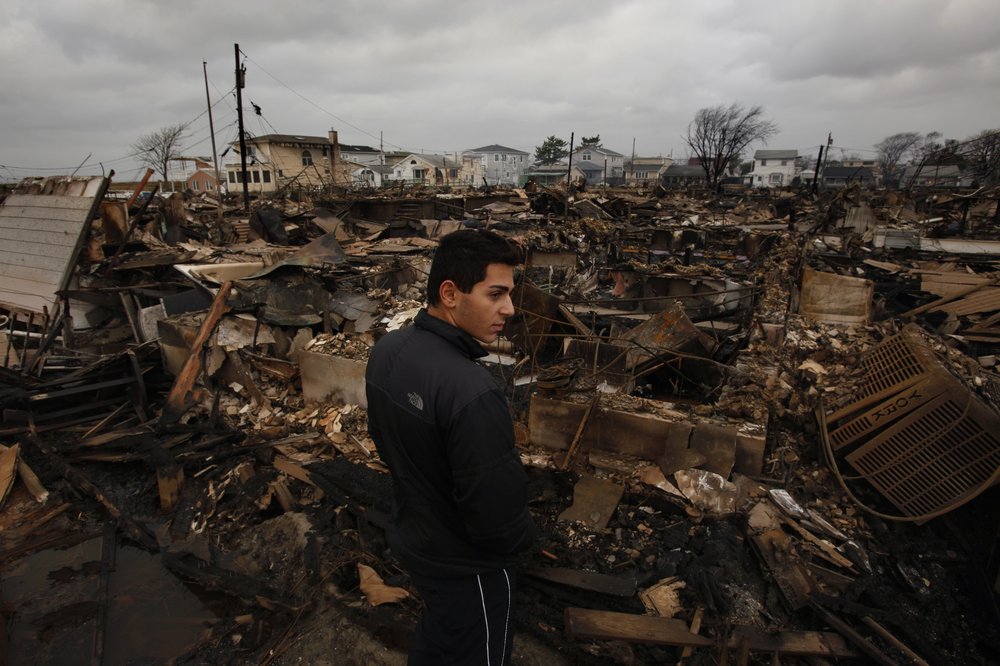Excess deaths from recent hurricanes hit 3 NY counties harder than most in U.S.
Aug. 16, 2023, 2:23 p.m.
A new analysis released by Columbia’s Mailman School of Public Health also finds wealthy people are more likely to survive a hurricane event.

For the last 35 years or so, most Americans who have died during hurricane events are among the society's most vulnerable people: They tend to be low-income, immigrants or people of color. They account for more than 90% of the death toll, according to a new study published Wednesday in the journal Science Advances.
The grim takeaways come from researchers at Columbia University’s Mailman School of Public Health who analyzed the 179 tropical cyclones that occurred in the Atlantic basin from 1988 to 2019. They looked at how those storms contributed to excess deaths — deaths beyond what are normally predicted for a given time frame after the storm — across the 1,200 U.S. counties that experienced at least one tropical cyclone during this period.
In total, the study estimated there were 3,112 excess deaths after hurricane winds initially subsided and another 15,590 fatalities after winds with violent storm force or gale strength dissipated. But in those hard-hit areas, some communities fared much worse than others.
On the researcher team’s top 20 list of U.S. counties with the deadliest hurricane events, the New York metro area made three appearances — all resulting from Hurricane Sandy. Nassau County came in fourth with 178 excess deaths; Staten Island was 15th with 104 fatalities and Brooklyn was 19th with 84 deaths. Ocean County, New Jersey was not far behind with 53 excess deaths during Sandy.
These excess death counts include more than the people who died during the storm or as a direct result of it, such those who drowned. They also account for cases in which residents may have died months after the storm from a condition that was either exacerbated by or a result of the weather event, such as high blood pressure or cardiovascular disease. Similar outcomes can happen to people with respiratory, neurological, parasitic and infectious diseases.
Despite New York's high ranking, flood-prone counties in southern U.S. states make up most of the list. Louisiana and Texas counties — Orleans Parish and Harris County, respectively — had the highest excess death tolls due to Hurricanes Katrina and Rita in 2005.
Florida’s Miami-Dade County appeared twice among the top 10 because of Hurricane Andrew in 1992 and Hurricane Irma in 2017 — as did neighboring Broward County, given Hurricane Irene in 1999 and Matthew in 2016.
The overall trend showed higher death tolls in more recent years. The analysis revealed that 83% of post-hurricane deaths and 70% of the post-gale deaths occurred from 2004 to 2019. The data is in line with climate change-related predictions that hurricanes and storms will be more frequent and more severe.
“In some ways Sandy is an outlier because the Northeast is one of the more affluent places in the United States, but the death count was rather large,” said Robbie Parks, the study’s lead author and an environmental health science professor at Columbia’s Mailman School of Public Health.
Unlike hurricane-ridden Florida,
Parks said a big factor behind New York's ranking is that the city — unlike hurricane-ridden Florida — hadn't expected Sandy's impact and was not as prepared. The region’s population density and economic disparities also played a role.
“If it was to hit a city, it'd be a higher death count expected, but also it's a function of the social system, the resilience of the infrastructure,” Parks said. “That comes down to how people are prepared; how people can cope with the onset of the cyclone; and then afterwards, how much opportunity is there to recover.”
The outcomes are not just limited to heart attacks and strokes; after a flood, the resulting mold can affect residents years after a storm subsides.
Stress is a big predictor of all of these outcomes.
Marianthi-Anna Kioumourtzoglou, Columbia University
“The big connection is stress,” said Marianthi-Anna Kioumourtzoglou, an assistant professor of environmental health sciences at Columbia and the senior author of the study. “If you lose property or if you've evacuated, your stress levels are off the roof, and stress is a big predictor of all of these outcomes.”
In a previous study, Kioumourtzoglou discovered a noticeable uptick in death rates in the days following the storm. The risk of death in an affected area can remain higher even six months after a hurricane.
Quantifying the public health aftershock of a hurricane could be a valuable tool in distributing resources before the next storm hits.
“This has important potential implications regarding expansion of warning systems and other public health preparedness measures,” said Kate Burrows, a public health sciences professor at the University of Chicago who was not affiliated with the study.
This expansion of messaging and warnings could include public health guidance leading up to, during and months after a storm. It could include reminders to stock up on essential medications or the distribution of backup generators to places that routinely flood during thunderstorms or hurricane storm surges.
“We need to be thinking not only of the direct effects of these extreme events, but also of the indirect impacts on human health,” Kioumourtzoglou said. “A better idea of the severity of experiencing this big event could be used for preparedness.”
A decade after Sandy, volunteer historians restore a Queens neighborhood's lost memories 10 years after Sandy, Hudson River tunnel just as vulnerable to flooding – and a fix isn’t coming until 2038 Coastal barriers finally begin to rise around NYC — but can they stop the next Hurricane Sandy?